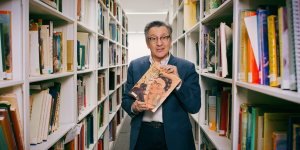‘I am not interested in anatomy or muscles in biological terms – I create my own configuration.’
-Manjit Bawa
Shiva has been depicted since the second century B.C., and for centuries, exquisitely carved stone and casted bronzes of the god were revered, not as objects of art, but objects of divine worship. People paid homage to the gods, and believed that the gods in turn granted blessings. In Indian modern art, depictions of Shiva diverge from religious iconography. From Kalighat paintings to the Bengal School, the Progressives to contemporary paintings, artists draw on pictorial traditions and use Shiva as a powerful motif, redefining what the divine looks like with a modern aesthetic.
In Manjit Bawa's Untitled (Shiva), Shiva is portrayed as Dakshinamurti, the depiction of Shiva as a teacher of yoga, music and wisdom. In this posture, Shiva is illustrated in a seated position, one leg bent with its foot resting on the opposite thigh. True to Bawa’s anatomical language, the figure appears invertebral, but his form nonetheless retains Dakshinamurti’s distinctive bodily configuration.
This awe-inspiring piece from 1995 leads the Modern & Contemporary South Asian Art auction taking place at Sotheby's London on 24 October along with other paintings, prints and sculptures from across India, Pakistan, Bangladesh and Sri Lanka.




